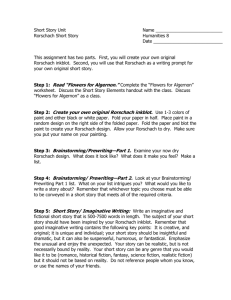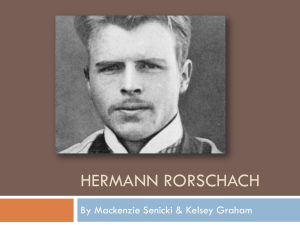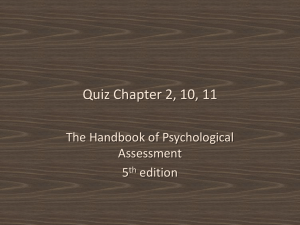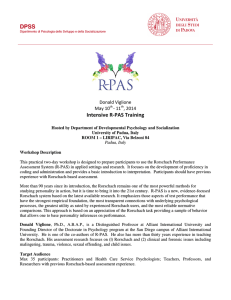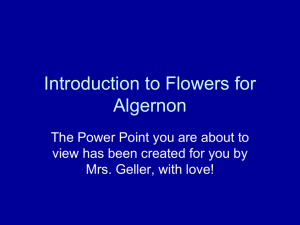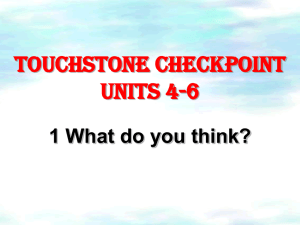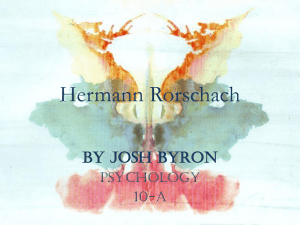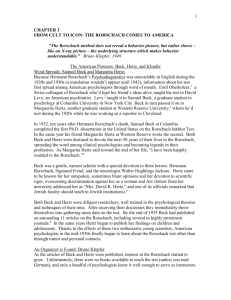PSYCH ∙ Ms. Wiley ∙ The Rorschach Test, D___ Name: Instructions
advertisement
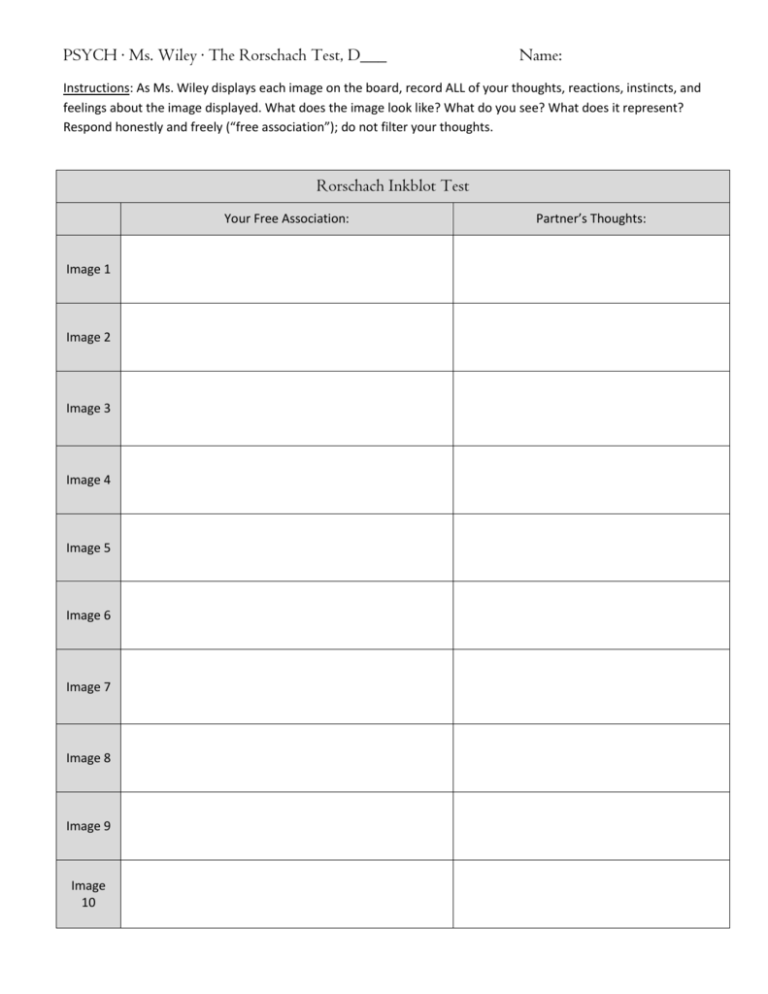
PSYCH ∙ Ms. Wiley ∙ The Rorschach Test, D___ Name: Instructions: As Ms. Wiley displays each image on the board, record ALL of your thoughts, reactions, instincts, and feelings about the image displayed. What does the image look like? What do you see? What does it represent? Respond honestly and freely (“free association”); do not filter your thoughts. Rorschach Inkblot Test Your Free Association: Image 1 Image 2 Image 3 Image 4 Image 5 Image 6 Image 7 Image 8 Image 9 Image 10 Partner’s Thoughts: The Rorschach Test (pronounced roar – shock) – Background: The Rorschach inkblot test is a psychological test in which subjects’ perceptions of inkblots are recorded and then analyzed using psychological interpretation, which includes complex algorithms. Some psychologists use this test to examine a person’s personality characteristics and emotional functioning. It has been employed to detect underlying disorders, especially in cases where patients are reluctant to describe their thinking processes openly. The test is named after its creator, Swiss psychologist Hermann Rorschach (aka Brad Pitt in a former life, see right), who developed the test in 1921 as a tool for diagnosing schizophrenia. Even today, its value as identifying schizophrenia is well accepted. The Rorschach test was devised as a way to assess unconscious processes by triggering the projection of unconscious thoughts or feelings. Though viewed as unique and revolutionary at the time, using interpretation of ambiguous designs to assess an individual’s personality, creativity, imagination and consciousness is an idea that goes back to Leonardo da Vinci and Botticelli. Method: Tester and subject typically sit next to each other at a table in a relaxed but controlled atmosphere. The test subject responds to 10 inkblots, each printed on a separate, large white card, in a “free association” phase, where they describe what they see in the image. They are not guided, or rushed, by the evaluator in any way. The session is often recorded to provide the administrator with all necessary information, such as content responses, secondary comments, body language, hand gestures, time gaps, length of response, etc. An evaluator would note, for example, whether the cards are rotated or whether permission to rotate them is asked; either action may expose personality traits and normally contributes to the assessment. Goals / Interpretation: The general goal of the test is to provide data about cognition and personality variables such as motivations, response tendencies, operations, affectivity, and personal/interpersonal perceptions. The underlying assumption is that an individual will class external stimuli based on base motives, needs, and perceptual sets, and that this clustering process is representative of the process used in reallife situations. The interpretation of Rorschach is a complex process. It requires a wealth of knowledge concerning personality dynamics as well as considerable experience with the Rorschach method. Proficiency as a Rorschach administrator can only be achieved after several years in practice. The interpretation of the test is not based primarily on the contents of the response, i.e., what the individual sees in the inkblot (the content). In fact, the contents of the response are only a comparatively small portion of a broader cluster of variables that are used to interpret the data: for instance, information is provided by the time taken before providing a response for a card can be significant, as well as by any comments the subject may make in addition to providing a general response. Popularity vs. “originality” of responses can also be considered as basic dimensions in the analysis. Content is classified in terms of “human”, “nature”, “abstract”, etc., as well as for statistical popularity (or, conversely, originality). Administrators of the test recognize that content response can be controlled consciously by the subject and may be elicited by very disparate factors, which makes it difficult to use content alone to draw any conclusions about the subject’s personality. Content is useful in so far as it demonstrates aspects of the way a subject perceives the world. For instance, answers such as “diseased lungs” or “the devil in flames” are not readily suggested by the features of the blot. Therefore, a pattern of responses such as these is more likely to suggest the presence of a disorder in the test taker. Popularity / Use Today: The test reached its height in popularity and use in the 1960s and has since fallen off due to concerns about reliability and validity. Today it is often used in tandem with other psychological tests to better understand patients of concern. Though it is still used by forensic psychologists, its reputation has been damaged by several U.S. court decisions since the 1990s. Inkblots and “Answers”: Below are the ten inkblots of the Rorschach test printed in Rorschach's Rorschach Test – Psychodiagnostic Plates; together with the most frequent responses for either the whole image or the most prominent details according to various authors. Please note that “popular responses” do not indicate the “correct answer”. [They are stated to satisfy our curiosity more than anything else.] Card Popular responses Beck: bat, butterfly, moth Piotrowski: bat (53%), butterfly (29%) Dana (France): butterfly (39%) Beck: two humans Piotrowski: four-legged animal (34%, gray parts) Dana animal: dog, elephant, bear (France): (50%, gray) Beck: two humans (gray) Piotrowski: human figures (72%, gray) Dana (France): human (76%, gray) Beck: animal hide, skin, rug Piotrowski: animal skin, skin rug (41%) Dana (France): animal skin (46%) Beck: bat, butterfly, moth Piotrowski: butterfly (48%), bat (40%) Dana (France): butterfly (48%), bat (46%) Beck: animal hide, skin, rug Piotrowski: animal skin, skin rug (41%) Dana (France): animal skin (46%) Beck: human heads or faces (top) Piotrowski: heads of women or children (27%, top) Dana human head (46%, top) (France): Comments When seeing card I, subjects often inquire on how they should proceed, and questions on what they are allowed to do with the card (e.g. turning it) are not very significant. Being the first card, it can provide clues about how subjects tackle a new and stressful task. It is not, however, a card that is usually difficult for the subject to handle, having readily available popular responses. The red details of card II are often seen as blood, and are the most distinctive features. Responses to them can provide indications about how a subject is likely to manage feelings of anger or physical harm. This card can induce a variety of sexual responses. Card III is typically perceived to contain two humans involved in some interaction, and may provide information about how the subject relates with other people (specifically, response latency may reveal struggling social interactions). Card IV is notable for its dark color and its shading (posing difficulties for depressed subjects), and is generally perceived as a big and sometimes threatening figure; compounded with the common impression of the subject being in an inferior position ("looking up") to it, this serves to elicit a sense of authority. The human or animal content seen in the card is almost invariably classified as male rather than female, and the qualities expressed by the subject may indicate attitudes toward men and authority. Because of this Card IV is often called "The Father Card". Card V is an easily elaborated card that is not usually perceived as threatening, and typically instigates a "change of pace" in the test, after the previous more challenging cards. Containing few features that generate concerns or complicate the elaboration, it is the easiest blot to generate a good quality response about. Texture is the dominant characteristic of card VI, which often elicits association related to interpersonal closeness; it is specifically a "sex card", its likely sexual percepts being reported more frequently than in any other card, even though other cards have a greater variety of commonly seen sexual contents. Card VII can be associated with femininity (the human figures commonly seen in it being described as women or children), and function as a "mother card", where difficulties in responding may be related to concerns with the female figures in the subject's life. The center detail is relatively often (though not popularly) identified as a vagina, which makes this card also relate to feminine sexuality in particular. Beck: animal: not cat or dog (pink) People often express relief about card VIII, which lets them relax and respond effectively. Similar to card V, it represents a "change of pace"; four-legged animal (94%, Piotrowski: however, the card introduces new elaboration difficulties, being pink) complex and the first multi-colored card in the set. Therefore, people Dana four-legged animal (93%, who find processing complex situations or emotional stimuli (France): pink) distressing or difficult may be uncomfortable with this card. Beck: human (orange) Piotrowski: none Dana (France): none Characteristic of card IX is indistinct form and diffuse, muted chromatic features, creating a general vagueness. There is only one popular response, and it is the least frequent of all cards. Having difficulty with processing this card may indicate trouble dealing with unstructured data, but aside from this there are few particular "pulls" typical of this card. Beck: crab, lobster, spider (blue) crab, spider (37%, blue), rabbit head (31%, light Piotrowski: green), caterpillars, worms, snakes (28%, deep green) Dana none (France): Card X is structurally similar to card VIII, but its uncertainty and complexity are reminiscent of card IX: people who find it difficult to deal with many concurrent stimuli may not particularly like this otherwise pleasant card. Being the last card, it may provide an opportunity for the subject to "sign out" by indicating what they feel their situation is like, or what they desire to know. Rorschach Inkblot Questions: 1. What is your reaction to the inkblot test? Based on the material presented, do you think it is a worthwhile test for psychologists to use? 2. Look back at your responses to the inkblot test. How do you think your responses, and behavior while taking the test, would be evaluated by a psychologist?

